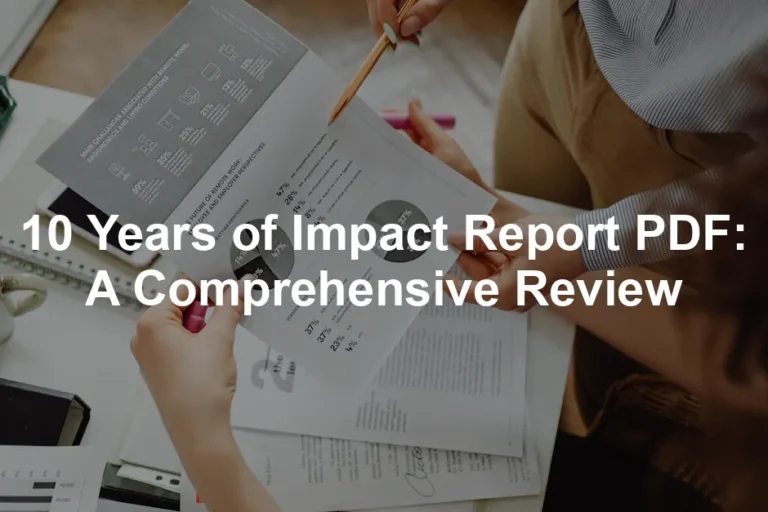Introduction
Pension systems play a crucial role in safeguarding financial stability for retirees. They provide a safety net, allowing individuals to enjoy their golden years without the constant worry of financial insecurity. As the world grapples with an aging population, understanding how different countries approach retirement planning becomes increasingly important.
This article aims to offer a thorough overview of pension statistics across various countries. By analyzing these systems, we can highlight the strengths and weaknesses of retirement plans worldwide. The insights gained will help individuals, policymakers, and organizations alike to understand the landscape of pensions.
If you’re looking for a great resource to kickstart your financial journey, consider grabbing Retirement Planning for Dummies. This book breaks down complex concepts into digestible bits, so you can plan for a comfortable retirement without pulling your hair out.
Comparing pension statistics globally is vital for grasping the effectiveness of diverse retirement systems. It reveals patterns, challenges, and potential best practices that could benefit countries facing similar issues. For instance, some nations excel in providing adequate income for retirees, while others struggle to maintain sustainable systems. By shining a light on these disparities, we can draw conclusions that may lead to more effective pension policies in the future.

Understanding the complexities of pension systems is essential for ensuring financial security in retirement. Learn more about the importance of statistical analysis in understanding these systems.
1. Understanding Pension Systems
1.1 Definition and Types of Pension Plans
A pension system consists of various components designed to provide income during retirement. At its core, a pension plan is a financial arrangement where contributions are made during an individual’s working life, ensuring they receive a steady income once they retire. The key components of pension systems include mandatory contributions, investment strategies, and benefit payouts.
Pension plans can be broadly categorized into three types: defined benefit, defined contribution, and hybrid systems.
- Defined Benefit Plans guarantee a specific payout upon retirement, often based on salary and years of service. Employers typically bear the investment risk, making this type attractive to employees seeking predictable income.
- Defined Contribution Plans place the investment risk on employees. In this model, both employees and employers contribute to an individual account, which is then invested. The retirement benefit depends on the account’s performance, meaning there’s no guaranteed payout.
- Hybrid Systems combine elements of both defined benefit and defined contribution plans. These systems offer some level of guaranteed income while allowing for personal investment choices.
Understanding these various pension structures is essential for analyzing their effectiveness in providing financial security for retirees. The differences in pension systems can significantly impact the quality of life for retired individuals across the globe.
If you’re looking to up your investing game, The Intelligent Investor by Benjamin Graham is a must-read. It’s like having a wise old uncle whispering investment secrets into your ear, and who doesn’t want that?

1.2 Importance of Pension Systems
Pension systems are vital for economic stability and personal financial security. They act as a safety net for retirees, allowing them to maintain their standard of living when they can no longer earn a paycheck. Without robust pension systems, many individuals would face financial hardships in their later years.
Moreover, the significance of pensions extends beyond individual security. They contribute to overall economic stability by ensuring that older adults can spend money and support local businesses. This spending helps stimulate the economy, creating a positive ripple effect.
As populations age, the dynamics of pension systems become increasingly complex. Countries with rising life expectancies face pressure to reform their pension schemes. An aging population means more retirees and fewer workers contributing to the system. This shift can lead to funding shortages, prompting governments to rethink their pension strategies.
In summary, pension systems are crucial for safeguarding financial independence in retirement. They also play a fundamental role in maintaining economic stability, especially in the face of demographic changes.

2. Global Pension Statistics Overview
2.1 Key Global Pension Statistics
When examining global pension systems, some eye-opening statistics come to light. According to OECD reports, total pension assets globally reached approximately $55 trillion in 2022. This figure reflects the growing importance of pensions in financial markets and the economy at large.
Average pension payouts vary significantly between countries. For instance, in the Netherlands, retirees enjoy an average pension payout of around $2,500 monthly, while in the United States, the average is closer to $1,600. Such discrepancies highlight the need for comprehensive reforms in underperforming systems.
Comparing pension fund assets to GDP provides additional insights. Countries like Canada and the Netherlands boast impressive ratios, with pension fund assets comprising 180% and 191% of their GDP, respectively. In contrast, countries such as the Philippines and India show much lower ratios, at around 2.8% and 9.3%. These figures underscore disparities in retirement planning and funding across different systems.
For those looking to take control of their finances, The Total Money Makeover is a game-changer. It’s like a financial boot camp that gets you in shape for retirement!

2.2 Methodology of Ranking Pension Systems
The Mercer CFA Institute Global Pension Index employs a rigorous methodology to assess retirement income systems globally. It uses three primary criteria: adequacy, sustainability, and integrity.
Adequacy focuses on the benefits provided by pension systems and their ability to meet the needs of retirees. Sustainability evaluates the long-term viability of these systems, considering factors like demographic changes and government debt. Finally, integrity examines the governance structures in place to protect pension plan members.
By analyzing over 50 indicators within these categories, the index offers a comprehensive view of each country’s pension landscape. This methodology allows for meaningful comparisons and highlights areas needing reform.
The index serves as a valuable tool for policymakers, helping them identify strengths and weaknesses in their pension systems. As countries grapple with aging populations and economic pressures, understanding these rankings becomes essential for ensuring financial security for future generations. To keep your financial future secure, check out The Psychology of Money. It provides insights that can help you navigate financial decisions with confidence.

3. Top Countries for Pension Systems
3.1 Analysis of Leading Pension Systems
3.1.1 Netherlands
The Netherlands boasts the top pension system globally, scoring an impressive 85.0 on the Mercer CFA Institute Global Pension Index. This system beautifully combines state pensions with mandatory occupational plans. The flat-rate public pension guarantees a baseline income, while industry-wide defined-benefit plans offer additional security.
One key strength lies in its sustainability. With pension fund assets reaching 191% of GDP, the Netherlands demonstrates a robust financial foundation. The country also excels in adequacy, ensuring retirees receive an income that keeps pace with living costs. In fact, the average monthly pension payment is around $2,500, allowing retirees to live comfortably. However, the government is focusing on increasing workforce participation and household savings to further bolster this already stellar system.

Want to know how to keep your finances in check? Check out The Bogleheads’ Guide to Investing. It’s a treasure trove of investing wisdom that will have you feeling like a financial guru in no time!
3.1.2 Iceland
Iceland’s pension system is another standout, earning an A rating with a score of 84.8. The system features a basic state pension, supplemented by mandatory contributions to occupational pensions from both employees and employers. This dual approach ensures that retirees have a stable income.
The effectiveness of Iceland’s system is reflected in its high average monthly pension payout of approximately €2,762. This places Iceland at the forefront of pension provision. Additionally, the country boasts a relatively low gender pension gap, promoting equality among retirees. Nevertheless, policymakers are urged to address issues like household debt to maintain long-term financial health.

3.1.3 Denmark
Denmark ranks third with a score of 81.3, showcasing a well-structured pension system that includes a basic public pension and mandatory occupational schemes. The Danish model emphasizes personal responsibility, encouraging individuals to save for retirement while still ensuring a reliable government payout.
Danish retirees enjoy a monthly pension around €1,400, making it a solid option for many. The sustainability of this system is commendable, with pension fund assets amounting to 37.81% of GDP. Denmark faces challenges with increasing life expectancy, prompting discussions on raising the retirement age. Yet, the system continues to adapt, providing a strong safety net for its citizens.
3.2 Insights on Other High-Performing Countries
Beyond the top three, several other nations present noteworthy pension systems. Israel, with a score of 80.8, offers a universal state pension alongside mandatory private pensions, ensuring that retirees receive adequate support. Australia, scoring 77.3, features a superannuation system that encourages savings through employer contributions, although it lacks a mandatory income stream.
Finland is also notable, with a score of 76.6. Its pension system combines a basic pension with supplementary components, providing a safety net for its aging population. Each of these countries demonstrates unique features that contribute to their high rankings, highlighting the importance of adapting pension systems to meet the needs of future retirees.

For those interested in the psychology behind wealth, The Richest Man in Babylon offers timeless lessons that can help guide your financial decisions.
In conclusion, analyzing these leading pension systems reveals valuable insights into the components that foster financial security for retirees. As countries continue to grapple with demographic changes, these models provide a roadmap for enhancing pension adequacy and sustainability worldwide.

4.1 Challenges in Pension Systems
Countries with the lowest pension rankings face significant hurdles. The United Kingdom, Philippines, and Argentina are prime examples. In these nations, many retirees struggle with low replacement rates. A replacement rate is the percentage of a worker’s pre-retirement income that their pension replaces. Unfortunately, in the UK, for instance, retirees receive only 29% of a working wage, the lowest among OECD countries. Meanwhile, in the Philippines, the situation is dire, with pension funds only covering a fraction of retirees’ needs.
Inadequate funding is another pressing issue. Many pension systems rely heavily on government support. When economic conditions sour, funding can become strained. For Argentina, a country already facing economic instability, this creates a precarious situation for retirees. The pension system struggles to maintain solvency, leaving many without sufficient income.
High dependency ratios further complicate matters. Dependency ratios measure the number of dependents (young and old) compared to the working-age population. In countries like the Philippines, this ratio remains alarmingly high, putting additional pressure on the pension system. With fewer workers contributing to the system, the funds available for payouts dwindle. Thus, many retirees are left to fend for themselves, often relying on family support or facing poverty.

4.2 Case Studies
4.2.1 United Kingdom
The UK’s pension system is a mix of state and private plans, yet it faces considerable challenges. With an aging population and increasing life expectancy, the system struggles to provide adequate retirement income. The state pension, while a foundation, often falls short of covering living expenses. Many retirees find themselves relying on means-tested benefits, which can be a frustrating experience.
Moreover, the shift from defined benefit plans to defined contribution plans has left many workers unprepared for retirement. A lack of savings and financial literacy contributes to this issue. As a result, many find themselves in a precarious financial position during their golden years. This situation calls for reforms that could enhance both adequacy and sustainability in the UK pension system.

4.2.2 Philippines
In the Philippines, pension systems in developing countries face unique barriers to improvement. The government offers a basic pension, but it’s often insufficient. Many workers in the informal sector lack access to pension plans, leaving them vulnerable in retirement. The existing pension system is fragmented and inadequate, with low coverage rates.
Moreover, cultural factors play a role in retirement planning. Many Filipinos rely on family support instead of saving for their retirement. This reliance on familial assistance can lead to insecurity, especially in times of economic hardship. Addressing these issues requires a concerted effort from the government and private sector to create a more inclusive and robust pension framework.

5.1 Europe
Europe showcases a veritable smorgasbord of pension systems, each as unique as a fine cheese platter. From generous payouts to complex funding structures, the diversity is astounding. For instance, the Netherlands leads the charge with a score of 85.0 on the Mercer CFA Institute Global Pension Index. Here, retirees enjoy an average monthly pension of about €2,500, thanks to a blend of state and occupational pensions.
In contrast, Bulgaria offers a less appetizing pension experience, with its average pension barely scraping by at €226. This stark difference raises questions about sustainability and adequacy. It’s not surprising that the EU’s average gross monthly pension hovers around €1,224. With countries like Luxembourg topping the list at around €2,575, the disparities can leave many scratching their heads.
Moreover, the European pension landscape is influenced by demographic factors. Countries with aging populations face increasing pressures on their pension funds. Nations such as Italy and Germany, where over 30% of the population are retirees, must navigate these challenges while ensuring their systems remain solvent and robust.

Thinking about diversifying your investments? Check out A Random Walk Down Wall Street. It’s a classic that can help you navigate the often murky waters of investing.
5.2 Asia
Asia’s pension systems are a tale of two extremes. On one hand, you have countries like Singapore, scoring a commendable 76.3 with its Central Provident Fund, a mandatory savings scheme that ensures a solid retirement income. On the other, nations like the Philippines, with a dismal score of 45.2, face significant struggles. Here, many rely on family support rather than a reliable pension system.
China’s system, encompassing both state and private elements, also faces challenges. With a score of 55.3, it shows potential but still lags behind. As the population ages, the need for reform becomes pressing. The balance between adequate support and economic viability remains a critical issue across the continent.
India, with a score of 45.9, illustrates the disparity between urban and rural pensions. While urban workers may have access to better schemes, rural populations often find themselves excluded from formal retirement plans, creating a significant gap in coverage.

5.3 Americas and Other Regions
North America boasts relatively strong pension systems, with Canada scoring 70.2 and the U.S. at 63.0. Canada’s Canada Pension Plan provides a solid foundation, while the U.S. relies heavily on Social Security, supplemented by private pensions. However, the adequacy remains a concern, especially as many retirees find their benefits insufficient to cover living expenses.
Latin America presents a mixed bag. Countries like Chile, with a score of 69.9, have made strides in pension reform, yet others, such as Argentina, languish at 42.3. Economic instability has left many retirees in Argentina struggling to make ends meet, raising alarms about the sustainability of their pension system.
In Africa, pension systems are often underdeveloped. South Africa, scoring 53.6, is an exception with a well-structured system that includes both public and private pensions. However, many countries in this region face challenges related to low coverage rates and inadequate funding, leaving millions without a safety net in retirement.
Overall, the economic conditions across the Americas and Africa significantly impact pension adequacy. As inflation rises and life expectancy increases, many countries will need to rethink their strategies to ensure that retirees can enjoy their golden years without financial worry.
If you’re interested in real estate investing, you might want to check out The Book on Rental Property Investing. It’s packed with insights that can help you build a profitable rental portfolio!
Please let us know what you think about our content by leaving a comment down below!
Thank you for reading till here 🙂
All images from Pexels




